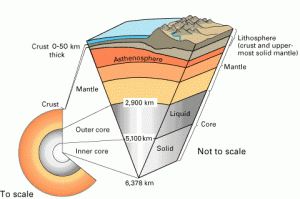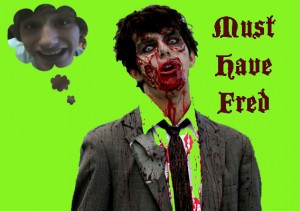There’s a continuum of video content online, and it’s often misunderstood because we polarize each end. Let’s stop bifurcating, and look at 3 layers of video content. There are advantages to each one, and we’re missing opportunity in “the great debate” between “professional” (networks) and “user-generated content” (UGC).

Layer 1: Professional content (the only “safe” place to advertise): Advertisers, when they’re not convincing marketers to create their own content, are often urging them to buy ads around “safe” professional content. We don’t see as many ads swarming around such user-generated content (UGC) as cats pooping on skateboards, or dogs riding toilets. Of course the influx of ad dollars into the online-video medium (which is trending upwards while most other ad mediums trend downward) will create a problem. Either ads will get expensive, or online-video’s professional content will have to expand rapidly. True, we’ve seen a proliferation of quasi-pro content that is almost as good as television, and far better produced than most online-video. Unfortunately, that market is hurting more than any because it has neither low production costs or large audiences.
Layer 3: User-generated content (the cheap buy): UGC offers much lower CPMs, so you can reach a wider audience efficiently. You can target specific niches or demographics, and the UGC viewer is, frankly, easier to distract from their content. Want to get someone to respond to your stupid “shoot the monkey” banner ad? You’ll have better luck on a weather and gaming sites than on a professional site (the Wall Street Journal, where audiences are generally engaged in the editorial content). YouTube has limited its number of “partners” who receive a portion of online ads, however. There’s a lot of crap among UGC and a lot of it is inappropriate for ads or copyright infringements. At some point, it’s not worth YouTube’s time to filter creators with tiny audiences. That’s not to say my videos are better than the guy that just started posting on YouTube, of course. Given a random a

Layer 2: The Hidden Online-Video Layer: The hidden layer is the overlooked one between pro and UGC, so I’ve decided to call it “The Hidden Video Layer.” I’m creative like that. And I’ll have to say this 100 times before anyone listens. It’s real, it’s big, it’s important to advertising, and most marketers don’t know it exists. Let’s look at three examples.
- If a YouTube partner (amateur) has a huge following (50 million views and 100K subscribers) on videos about videogames, we’d agree that it’s an incredibly smart place for ads and sponsorships selling the Wii or acne cream. There’s lots of ad inventory in that “hidden layer.” Fred — the most popular kid on YouTube — draws more daily views than many prime-time television shows. More importantly, when you aggregate the views of the top 100 amateur creators, you’ll far exceed the audience of almost any daily television show! Little old Uncle Nalts may have 60 million cumulative views, but gets 100K plus views a day. But combine me with a few more, and you’ve got traffic that beats many websites (and the audience is more engaged).
- If Yahoo saw fit to create a 24×7 “Lindsay Lohan Online-Video Show,” that’s where you’d want to sell your latest Lindsay Lohan action figure (handcuff accessories sold separately). The video content certainly wouldn’t need to be “professionally produced,” and arguably you’d want to keep costs down to $200 per minute. This channel, while not worthy of professional production, is certainly not UGC. BTW- I’m not advocating for a Lohan network any more than I understand Nancy Grace covering the Tot Mom the past 6 months. Jessica fell into a well, hon, and we’re over it.
- To use a non-video example, your aunt’s blog about her daily struggle with foot fungus is somewhat different from the popular TechCrunch blog. But we call them both blogs, and media loooooves its recent stories about bloggers failing to make a living on the medium. Four years ago, we saw stories about brave editors ditching media corporations and starting their own profitable life as a blogger. It’s simple: a blog’s not a blog. And a video channel isn’t a video channel. If you’re advertising, you want to reach large but targeted audiences. That usually means you’re surrounding or interrupting professional content, but not for online video at this point in time. Making well-produced content doesn’t guarantee viewers any more than creating amateur content guarantees a lack of an audience. Make sense? I sometimes spend hours on these posts and minutes on my videos, and dozens will read these words while hundreds of thousands will see my videos. Bad example since neither are professional.

Now this “missing video layer” offers advertisers 8 unique distinctions. I’m holding up four fingers on each of my hands right now, and jumping up and down.
- Established audiences. No smart producer or advertiser would try to build a new Fred show- Fred already has nearly one million people that have “subscribed” and are waiting for his next video. If I pitched “Fred” to NBC two years ago, I’d have been tossed from the building. But Fred usually gets far more views per video than almost any professional content online. Would you rather “roll the dice” by shooting a viral video, developing branded entertainment, or simply leverage Fred to reach “asses in seats”? Many amateur video creators on YouTube, for instance, have audiences that surpass those of entire video sites.
- Loyal and Passionate Audiences: viewers consume their YouTube stars like zombies in pursuit of a brain. It’s an indisputable fact. If Fred starting wearing Madonna rings on his wrist, they’d be back in style.
- Quality: It’s not “professional and TV-like,” but it’s good enough for the audience. I’d rather watch someone I like on a webcam than a boring sitcom or reality-show in HD. If you trust audiences will eventually migrate to “quality” content, then please reexamine what quality means in this medium (at least in 2009).
- Relevance: Ad targeting is easier as we move deeper into amateur content. “The Onion” has brilliant comedy, but “You Suck at Photoshop” probably has a more specified demographic that helps brands target. You want to reach people that celebrate their adolescence (at any age) or soccer moms? Check out Nalts. But Uncle Nalts isn’t likely to deliver too many right-wing, wealthy, retired men to sell time share or cigars. Relevance is easier now that video content and audiences are growing and fragmenting. Growfragmenting. Want to sell toe fungus medicine? Go to a toe fungus blog, not a health ‘n wellness website. There’s a reason Google text ads outperform almost any targeted display media buy. Relevance. Unfortunately, this makes an ad buyer’s job quite complex and will require more creative treatments than television. But video makers take note: this means we’ll need more than three versions of our 60-second spot (default, gay, and the Hispanic/African American). And if creative budgets aren’t getting bigger, than amateur video creators are well poised.
- Ad-Safe Content: Unlike regular UGC, most of “the hidden video layer” content is vetted to be ad friendly (a YouTube partner, for example, gets dumped if they break “terms of service” rules like being fowl or violating copyright laws). That’s as true for Nalts as it is for The Universal Music Group’s popular channel on YouTube.
- Economic Sustainability: Most of “amateur stars” have low costs. So many are making a comfortable living while expensive video sites struggle (Funny or Die). As an advertiser, I’d rather do a deal with content or a distribution channel that is profitable.
- Cost-Efficient Spends: You can saturate Fred’s channel with ads, or work with him and YouTube on a program that does far more than ads alone. Premium video creators, by contrast, simply need to charge higher CPMs given their higher cost-structure-per-view.
- Scale: The deeper advertisers go into “the long tail” of video content the better their chances of being able to broaden and scale campaigns without sacrificing targeting & relevance. We may temporarily saturate some niches, but if there’s audience and advertiser demand, new creators will appear.
We’ve allowed ourselves — as viewers, advertisers, and creators — to obsess on the polars of the content continuum: From Oprah to “David After the Dentist.” From “Lost” to and “the giggling infant.” From “The Office” to “monkey smelling its finger.” There’s a lot in between.
There’s goals in them niche hills, advertisers. Gooolllllddd (he cackles with toothless grin and ominous, shaking index finger). Then again, during a gold rush I like selling shovels.
